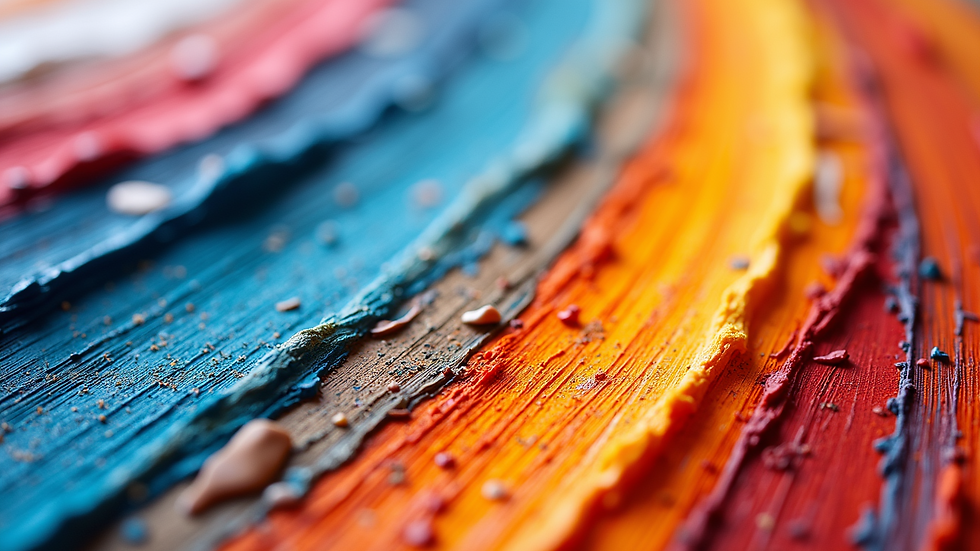Mastering the Abstract Still Life Painting Process
- billyandsuzzoo5
- Jun 23
- 4 min read
The world of abstract still life painting is a captivating realm where colors, shapes, and textures converge to create visually striking compositions. If you’re an artist looking to explore this genre or someone who wishes to develop their creativity, mastering the abstract still life painting process can be incredibly rewarding. In this post, we will delve into various abstract painting techniques, explore the creative process of still life art, and offer practical tips to help you elevate your artistic expression.
Understanding Abstract Painting Techniques
Abstract painting techniques are diverse, allowing artists to express their ideas and emotions freely. Unlike traditional still life that focuses on realism, abstract still life shifts attention to the emotional resonance of the objects depicted.
One popular technique is color blocking. This approach involves dividing the canvas into different sections filled with contrasting colors. For instance, you can create a vibrant background filled with warm hues like oranges and yellows while rendering the objects in cooler shades like blue or green. This contrast draws the viewer's eye and adds depth to the composition.
Texture application is another essential technique. Using tools such as palette knives or sponges, artists can create visually dynamic surfaces that engage the viewer. By layering paint thickly, you can introduce dimension and excitement to your artwork. Don’t be afraid to experiment with different materials like sand or fabric for added texture.

Finding Inspiration for Your Abstract Still Life
Inspiration can come from various sources. A walk in nature, the vibrant hues of fruits at a market, or even the shadows cast by everyday objects can spark ideas for your still life compositions. It’s crucial to keep a sketchbook handy or use your smartphone to jot down ideas.
Consider visiting galleries or attending art shows. Observing how other artists interpret the still life genre can offer valuable insights and help refine your style. Remember that inspiration is everywhere; it’s about training your eye to see the beauty in the ordinary.
Selecting Your Objects
Choosing objects for your still life composition is an integral part of the process. Unlike traditional still life where realistic depictions are paramount, you have the liberty to select objects that resonate with you on a deeper level.
Consider integrating personal items, such as a cherished book or a unique vase, that tell a story. Alternatively, explore the juxtaposition of organic and inorganic forms, such as fruits alongside geometric shapes. Playing with contrast can add intrigue.
Sketching Your Composition
Before diving into painting, it's advisable to create preliminary sketches. This helps map out your composition and understand how the objects interact with one another.
Begin with light pencil sketches to define the positions of each object. Play with varying angles—some painters prefer a high angle for a dramatic view, while others use an eye-level perspective for a more intimate feel. Remember, the composition should evoke an emotional response, so don’t hesitate to alter proportions and perspectives.

Transitioning to the Canvas
Once your sketch is complete, it's time to transfer your ideas to canvas. Here are some essential steps to consider during this transition:
Select Your Color Palette: Choose colors that complement your intended mood. For calmness, soft pastels work wonders; for excitement, opt for bold and saturated hues. Keep in mind the principles of color theory—complementary colors can enhance visual interest.
Layering the Paint: Start with an undercoat using a broad brush to lay down the foundation. As you build your painting, introduce colors gradually while allowing each layer to dry. This layering technique enhances depth.
Adding Highlights and Shadows: To create a three-dimensional effect, pay attention to light sources in your composition. Use lighter shades to highlight portions of your objects and darker tones to signify shadows.
Incorporating the Abstract Elements
As you paint, allow your emotions to guide some spontaneous choices, and don't hesitate to step back from the realistic forms. Mixing abstract qualities into your still life allows for personal expression and storytelling.
Consider the use of line work to create structure in your painting or splashes of color for emotional impact. Abstract elements such as drips and splatters can enhance your work, creating movement and interaction across the canvas.

Embracing the Final Touches
Once you've painted your composition, it's time to evaluate the overall piece. How does it evoke emotion? Does the color scheme achieve the desired impact? Here are some final considerations:
Balance and Harmony: Ensure that the elements in your painting work cohesively. Adjust color intensities and shapes to achieve harmony.
Textural Details: If you haven’t added enough texture, consider incorporating mixed-media elements or using various tools for finishing touches.
Sign Your Artwork: No piece is complete without your signature. This final action acknowledges your artistic effort.
Showcasing Your Work
After completing your masterpiece, think about how to showcase your abstract still life art. You can share your work online through social media platforms or personal blogs. Engaging with art communities not only helps gain feedback but can also inspire others through your journey.
You may also wish to host a small exhibition or participate in local art shows. The excitement of seeing your work displayed publicly can be a significant motivator for future projects.
The Joy of Abstract Still Life Painting
As you explore the process of creating abstract still life paintings, remember that mastery requires practice, patience, and an open mind. Embrace the freedom to express yourself without the constraints of realism.
Every stroke, color choice, and texture adds a new layer to your personal artistic journey. Don’t be afraid to make mistakes; they can often lead to groundbreaking ideas and stunning works of art. By harnessing the techniques outlined in this post, you can develop your unique style and leave a lasting impression through your abstract still life paintings.
Whether you’re a seasoned artist or a curious beginner, there’s endless joy and discovery awaiting in the expansive world of abstract painting techniques. Happy painting!


Comments